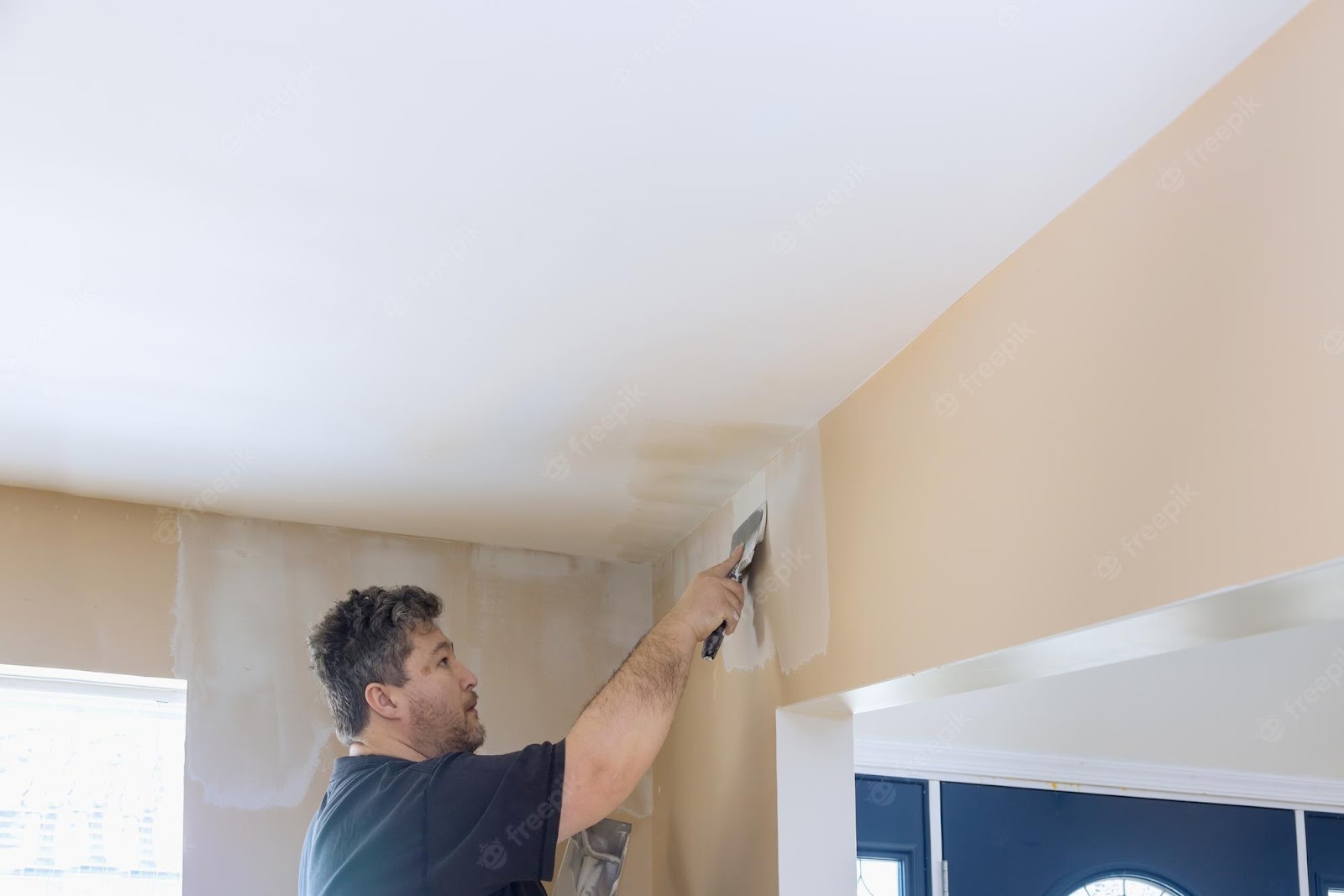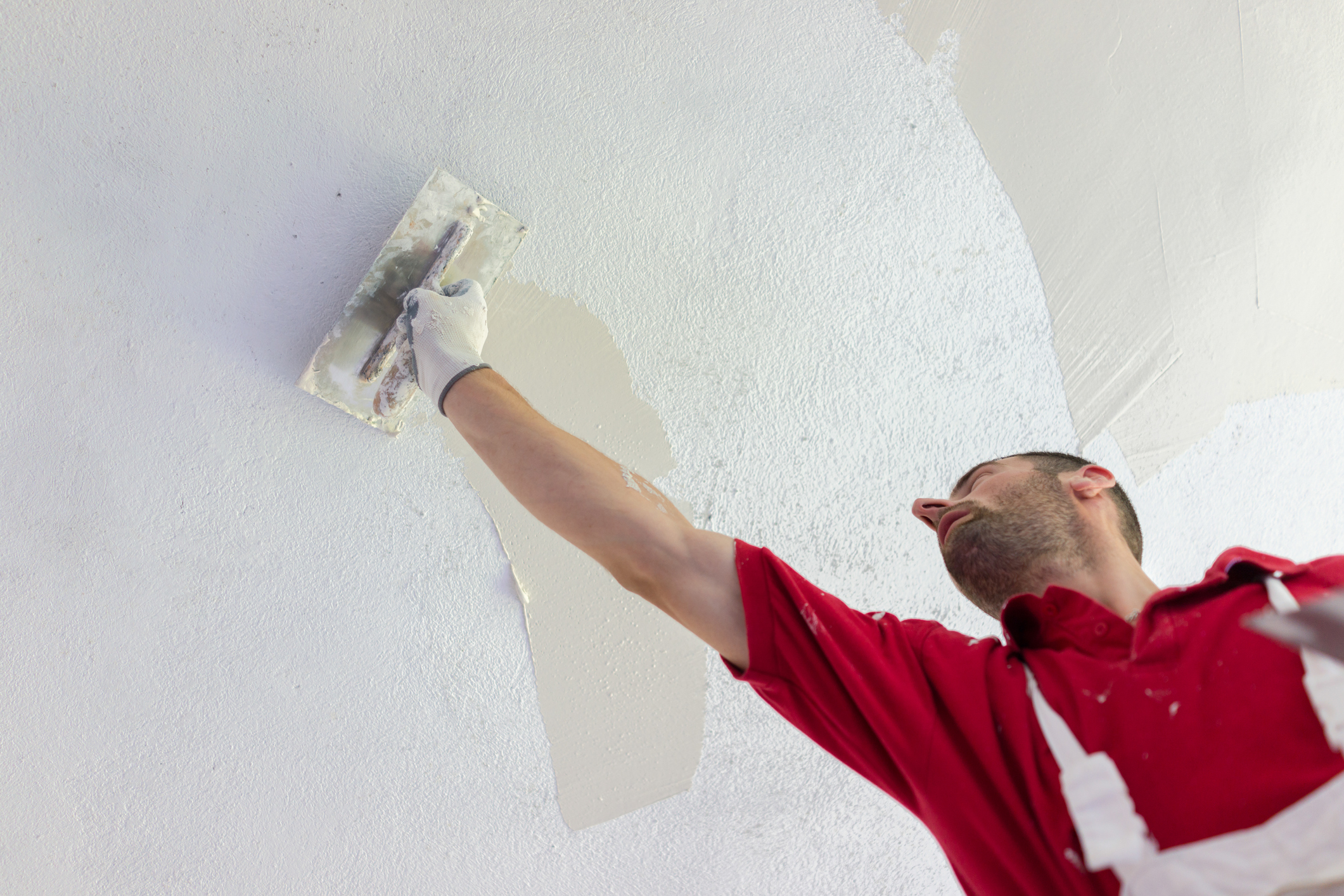Preparing the Bathroom Ceiling: Painting Plaster Ceiling In Bathroom

A well-prepared bathroom ceiling is crucial for a smooth and long-lasting paint job. This involves cleaning the surface, patching any imperfections, and sanding for a uniform finish.
Cleaning the Bathroom Ceiling
Thorough cleaning removes dirt, grime, and mildew, which can interfere with paint adhesion.
- Safety Precautions: Wear safety goggles to protect your eyes from dust and debris. Use a respirator mask to avoid inhaling dust and fumes.
- Tools and Materials:
- Step ladder or scaffolding for safe access to the ceiling
- Dustpan and broom or vacuum cleaner with a brush attachment
- Bucket of warm water
- Soft-bristled brush or sponge
- Mild detergent (avoid harsh chemicals)
- Clean cloths or paper towels
- Steps:
- Remove any loose objects or fixtures from the ceiling.
- Use a broom or vacuum cleaner to remove dust and cobwebs from the ceiling.
- Mix a mild detergent solution in the bucket of warm water.
- Dip the brush or sponge into the solution and gently scrub the ceiling, paying attention to areas with mildew or stains.
- Rinse the ceiling thoroughly with clean water.
- Dry the ceiling completely with clean cloths or paper towels.
Patching Imperfections
Cracks, holes, and uneven surfaces need to be patched before painting to create a smooth and even finish.
- Tools and Materials:
- Putty knife
- Spackling paste or joint compound
- Sandpaper (various grits)
- Masking tape
- Drop cloths
- Steps:
- Use a putty knife to remove loose or flaking paint, dirt, or debris from the areas to be patched.
- Apply masking tape around the edges of the imperfections to prevent the spackling paste or joint compound from spreading.
- Use a putty knife to apply spackling paste or joint compound to the imperfections, filling them completely and smoothing the surface.
- Allow the patching compound to dry completely according to the manufacturer’s instructions.
- Sand the patched areas with fine-grit sandpaper to smooth out any rough edges and create a seamless transition with the surrounding ceiling.
Sanding the Bathroom Ceiling
Sanding the ceiling helps to create a smooth and even surface that will accept paint evenly.
- Tools and Materials:
- Sandpaper (various grits)
- Sanding block or pole sander
- Dust mask and safety goggles
- Vacuum cleaner with a brush attachment
- Steps:
- Start with coarse-grit sandpaper to remove any remaining imperfections or rough patches.
- Gradually transition to finer-grit sandpaper to create a smooth and even surface.
- Use a sanding block or pole sander to reach the entire ceiling area.
- Vacuum the ceiling thoroughly to remove sanding dust.
Choosing the Right Paint

Selecting the right paint for your bathroom ceiling is crucial, as it must withstand the unique challenges of this high-moisture environment. The wrong choice can lead to peeling, cracking, and even mold growth.
Types of Paint for Bathroom Ceilings
The most common types of paint used for bathroom ceilings include latex, acrylic, and epoxy. Each has its own advantages and disadvantages, making the choice dependent on specific needs and preferences.
Latex Paint
Latex paint is a water-based paint commonly used for interior walls and ceilings due to its ease of application and quick drying time. It is also relatively inexpensive compared to other types.
- Advantages:
- Easy to apply and clean up with soap and water.
- Dries quickly.
- Available in a wide range of colors and finishes.
- Relatively inexpensive.
- Disadvantages:
- Less durable than other types of paint, making it prone to chipping and cracking.
- May not be as moisture-resistant as acrylic or epoxy paints, especially in high-humidity environments.
Acrylic Paint
Acrylic paint is a type of latex paint that offers improved durability and moisture resistance. It is a popular choice for bathroom ceilings due to its ability to withstand high humidity levels.
- Advantages:
- More durable than latex paint, making it less prone to chipping and cracking.
- Offers better moisture resistance, making it a suitable choice for high-humidity environments.
- Available in a wide range of colors and finishes.
- Disadvantages:
- More expensive than latex paint.
- May require more time to dry.
Epoxy Paint
Epoxy paint is a two-part paint that forms a hard, durable, and moisture-resistant coating. It is often used in industrial settings due to its exceptional durability and resistance to chemicals.
- Advantages:
- Extremely durable and resistant to chipping, cracking, and abrasion.
- Offers excellent moisture resistance, making it ideal for high-humidity environments.
- Resistant to mold and mildew growth.
- Disadvantages:
- More expensive than latex and acrylic paints.
- Requires more time to apply and cure.
- Can be difficult to remove if needed.
Key Considerations for Choosing Paint
When selecting paint for your bathroom ceiling, several factors should be considered to ensure the paint is suitable for the environment and provides the desired durability and protection.
- Moisture Resistance: Bathrooms are prone to high humidity levels, so choosing a paint with excellent moisture resistance is essential. Acrylic and epoxy paints are better suited for these environments than latex paint.
- Mildew Resistance: Mold and mildew can thrive in humid environments, so choosing a paint with mildew-resistant properties is crucial. Acrylic and epoxy paints offer better mildew resistance than latex paint.
- Durability: The bathroom ceiling is subjected to frequent cleaning and potential moisture exposure. Choosing a durable paint that can withstand these conditions is essential. Acrylic and epoxy paints offer superior durability compared to latex paint.
- Color and Finish: While functionality is paramount, the aesthetic appeal of the paint should also be considered. A variety of colors and finishes are available, allowing for a customized look to complement the bathroom’s design.
Comparing Paint Types for Bathroom Ceilings
| Paint Type | Properties | Pros | Cons |
|---|---|---|---|
| Latex | Water-based, easy to apply, dries quickly, inexpensive | Easy to apply and clean up, dries quickly, available in a wide range of colors and finishes, inexpensive | Less durable, not as moisture-resistant as acrylic or epoxy, prone to chipping and cracking |
| Acrylic | Water-based, durable, moisture-resistant, mildew-resistant | More durable than latex, better moisture resistance, available in a wide range of colors and finishes | More expensive than latex, may require more time to dry |
| Epoxy | Two-part, hard, durable, moisture-resistant, chemical-resistant | Extremely durable, excellent moisture resistance, resistant to mold and mildew growth | More expensive than latex and acrylic, requires more time to apply and cure, can be difficult to remove |
Painting Techniques

Painting a bathroom ceiling requires specific techniques to ensure a smooth, even finish that resists moisture and lasts. Applying paint correctly is crucial to achieving a professional look and preventing common issues like drips, streaks, and uneven coverage.
Applying Paint Evenly and Smoothly
To achieve an even and smooth paint application on a bathroom ceiling, consider these tips:
- Use a high-quality brush or roller: A brush with soft bristles and a roller with a nap length suitable for the texture of your ceiling will help distribute paint evenly.
- Load the brush or roller properly: Dip the brush or roller into the paint, but avoid overloading it. Excess paint will lead to drips and runs.
- Apply thin, even coats: Apply thin, even coats of paint instead of thick, heavy coats. This will help the paint dry evenly and prevent drips.
- Work in sections: Divide the ceiling into manageable sections, applying paint to each section in a consistent direction. This ensures even coverage and prevents streaks.
- Use a paint extension pole: A paint extension pole allows you to reach the entire ceiling without straining.
- Use a paint tray liner: A paint tray liner helps keep your paint clean and free of debris.
Common Mistakes to Avoid, Painting plaster ceiling in bathroom
Avoiding common mistakes while painting a bathroom ceiling is essential for achieving a professional finish:
- Not prepping the ceiling properly: This includes cleaning the ceiling, filling cracks and holes, and sanding the surface to ensure a smooth, even base for the paint.
- Using the wrong type of paint: Bathroom ceilings require moisture-resistant paint.
- Applying paint too thickly: Thick coats of paint can lead to drips, runs, and uneven coverage.
- Not allowing sufficient drying time between coats: Applying the next coat before the previous coat is completely dry can cause the paint to peel or crack.
- Not cleaning up properly: Leaving paint spills and splatters can damage the ceiling and make the room look messy.
Achieving a Professional-Looking Finish
To achieve a professional-looking finish on a bathroom ceiling, consider these techniques:
- Use painter’s tape: Painter’s tape helps protect surrounding surfaces from paint splatters and creates clean, sharp lines.
- Use a paint shield: A paint shield helps prevent paint drips from falling onto the walls or floor.
- Use a paint roller extension pole: This allows you to reach the entire ceiling without straining.
- Use a paint brush for corners and edges: A paint brush is ideal for reaching tight spaces and ensuring a smooth finish around corners and edges.
- Apply paint in smooth, even strokes: Avoid applying paint in a haphazard manner, as this can lead to streaks and uneven coverage.
- Use a paint roller with a nap length suitable for the ceiling texture: This ensures that the paint is evenly distributed and does not leave streaks.
- Use a paint thinner to clean up any spills or splatters: This helps prevent the paint from drying and becoming difficult to remove.
